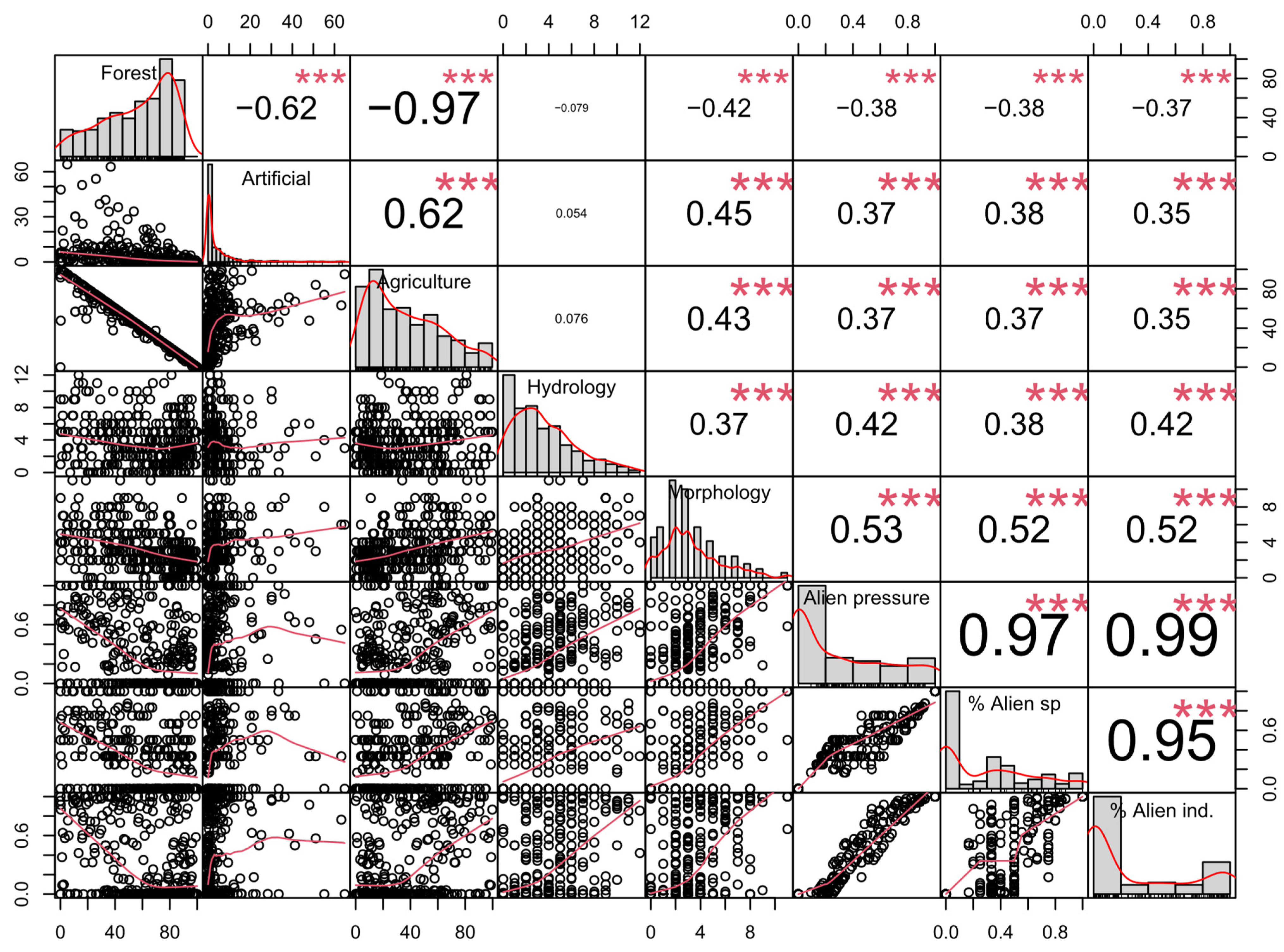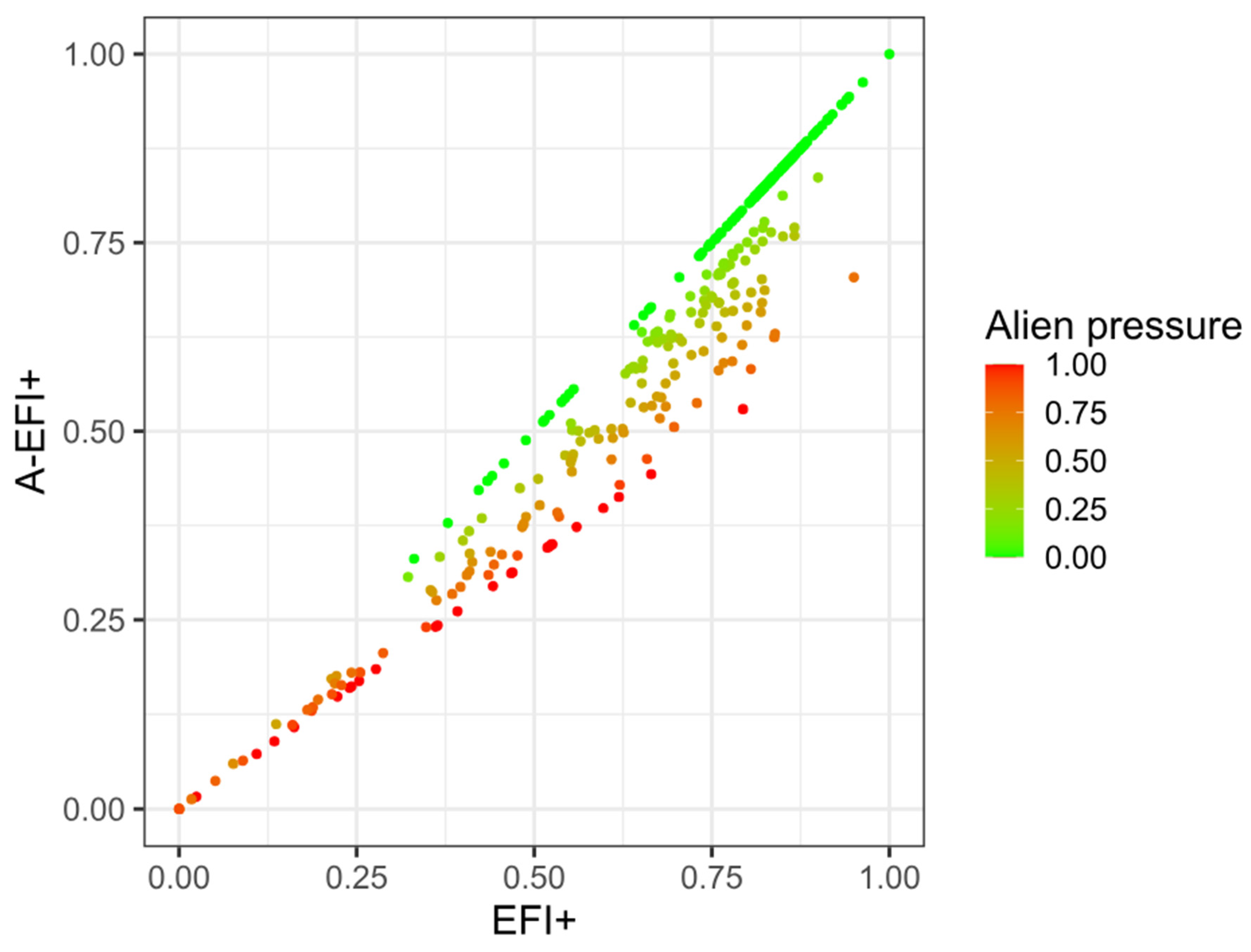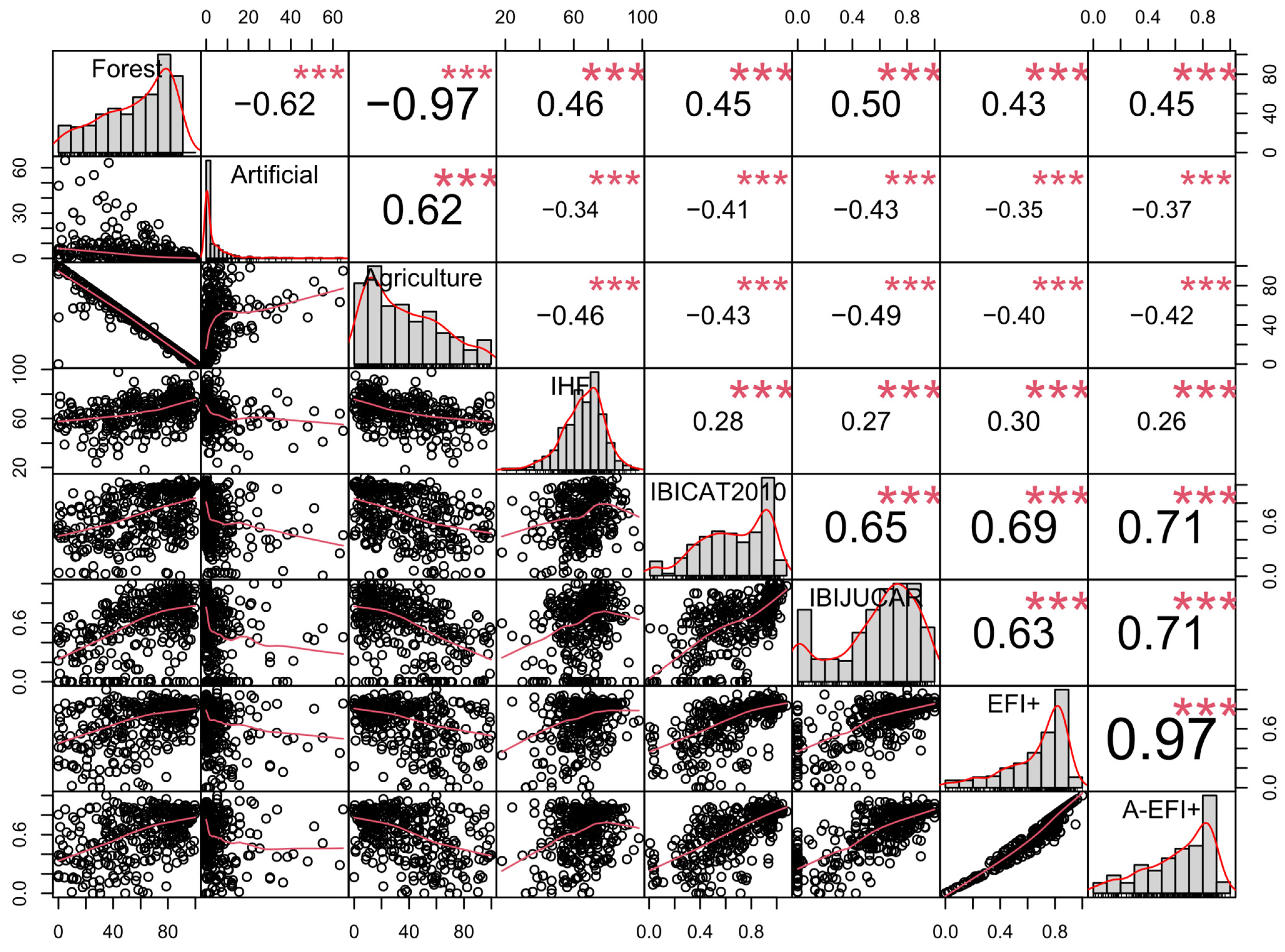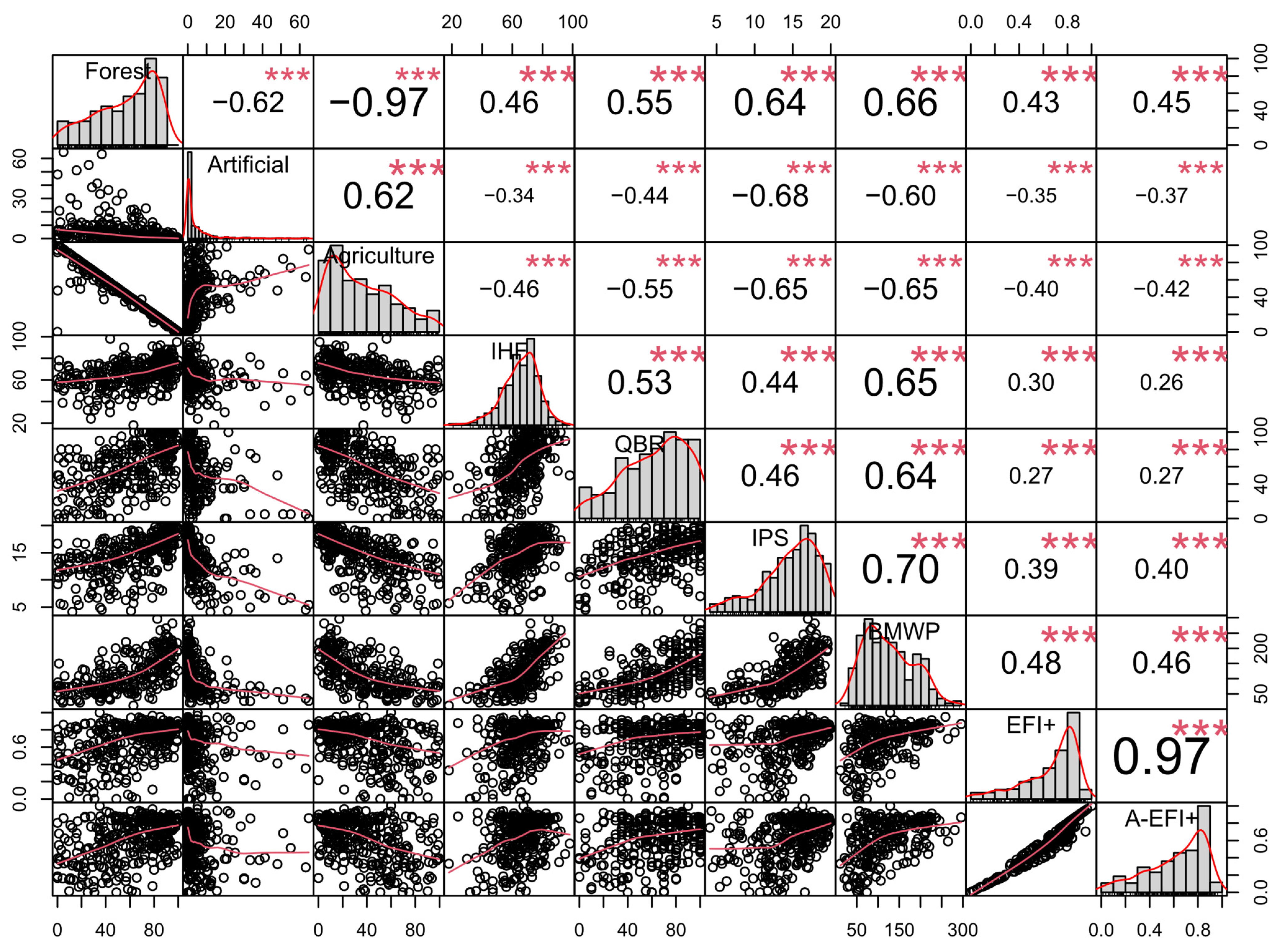Adaptation of the European Fish Index (EFI+) to Include the Alien Fish Pressure
Abstract
1. Introduction
2. Materials and Methods
3. Results
4. Discussion
5. Conclusions
Author Contributions
Funding
Institutional Review Board Statement
Data Availability Statement
Acknowledgments
Conflicts of Interest
References
- European Union Directive 2000/60/EC of the European Parliament and the Council of 23 October 2000 Establishing a Framework for Community Action in the Field of Water Policy. Off. J. Eur. Communities 2000, 43, L327.
- Karr, J.R. Assessment of biotic integrity using fish communities. Fisheries 1981, 6, 21–27. [Google Scholar] [CrossRef]
- Fausch, K.D.; Lyons, J.; Karr, J.R.; Angermeier, P.L. Fish communities as indicators of environmental degradation. In Proceedings of the American Fisheries Society Symposium, Pittsburgh, PA, USA, 26–30 August 1990; AFS Publications: Bethesda, Maryland, 1990; Volume 8, pp. 123–144. [Google Scholar]
- Fullerton, A.H.; Burnett, K.M.; Steel, E.A.; Flitcroft, R.L.; Pess, G.R.; Feist, B.E.; Torgersen, C.E.; Miller, D.J.; Sanderson, B.l. Hydrological connectivity for riverine fish: Measurement challenges and research opportunities. Freshw. Biol. 2010, 55, 2215–2237. [Google Scholar] [CrossRef]
- FAME Consortium Manual for the Application of the European Fish Index—EFI. A Fish-Based Method to Assess the Ecological Status of European Rivers in Support of the Water Framework Directive; BOKU: Viena, Austria, 2004.
- Pont, D.; Hugueny, B.; Rogers, C. Development of a fish-based index for the assessment of river health in Europe: The European Fish Index. Fish. Manag. Ecol. 2007, 14, 427–439. [Google Scholar] [CrossRef]
- EFI+ Consortium Manual for the Application of the New European Fish Index-EFI+. A Fish-Based Method to Assess the Ecological Status of European Running Waters in Support of the Water Framework Directive; BOKU: Viena, Austria, 2009.
- European Environment Agency (EEA). European Waters—Assessment of Status and Pressures; European Environment Agency: Luxembourg, 2018.
- Clavero, M.; García-Berthou, E. Homogenization dynamics and introduction routes of invasive freshwater fish in the iberian peninsula. Ecol. Appl. 2006, 16, 2313–2324. [Google Scholar] [CrossRef] [PubMed]
- Hermoso, V.; Clavero, M.; Blanco-Garrido, F.; Prenda, J. Invasive species and habitat degradation in Iberian streams: An analysis of their role in freshwater fish diversity Loss. Ecol. Appl. 2011, 21, 175–188. [Google Scholar] [CrossRef] [PubMed]
- Ribeiro, F.; Leunda, P.M. Non-native fish impacts on Mediterranean freshwater ecosystems: Current knowledge and research needs. Fish. Manag. Ecol. 2012, 19, 142–156. [Google Scholar] [CrossRef]
- Ramos-Merchante, A.; Prenda, J. The ecological and conservation status of the Guadalquivir River Basin (s Spain) through the application of a fish-based multimetric index. Ecol. Indic. 2018, 84, 45–59. [Google Scholar] [CrossRef]
- Aparicio, E.; Carmona-Catot, G.; Moyle, P.B.; García-Berthou, E. Development and evaluation of a fish-based index to assess biological integrity of Mediterranean streams. Aquat. Conserv. Mar. Freshw. Ecosyst. 2011, 21, 324–337. [Google Scholar] [CrossRef]
- Aparicio, E.; Vargas, M.J.; Olmo, J.M.; De Sostoa, A. Decline of native freshwater fishes in a Mediterranean watershed on the Iberian Peninsula: A quantitative assessment. Environ. Biol. Fishes 2000, 59, 11–19. [Google Scholar] [CrossRef]
- Radinger, J.; Alcaraz-Hernández, J.D.; García-Berthou, E. Environmental filtering governs the spatial distribution of alien fishes in a large, human-impacted Mediterranean river. Divers. Distrib. 2019, 25, 701–714. [Google Scholar] [CrossRef]
- Boon, P.J.; Clarke, S.A.; Copp, G.H. Alien species and the EU Water Framework Directive: A comparative assessment of European approaches. Biol. Invasions 2020, 22, 1497–1512. [Google Scholar] [CrossRef]
- Segurado, P.; Caiola, N.; Pont, D.; Oliveira, J.M.; Delaigue, O.; Ferreira, M.T. Comparability of fish-based ecological quality assessments for geographically distinct Iberian regions. Sci. Total Environ. 2014, 476–477, 785–794. [Google Scholar] [CrossRef] [PubMed]
- Almeida, D.; Alcaraz-Hernández, J.D.; Merciai, R.; Benejam, L.; García-Berthou, E. Relationship of fish indices with sampling effort and land use change in a large Mediterranean river. Sci. Total Environ. 2017, 605–606, 1055–1063. [Google Scholar] [CrossRef] [PubMed]
- Zogaris, S.; Tachos, V.; Economou, A.N.; Chatzinikolaou, Y.; Koutsikos, N.; Schmutz, S. A model-based fish bioassessment index for Eastern Mediterranean rivers: Application in a biogeographically diverse area. Sci. Total Environ. 2018, 622–623, 676–689. [Google Scholar] [CrossRef] [PubMed]
- Adamczyk, M.; Prus, P.; Buras, P.; Wiśniewolski, W.; Ligięza, J.; Szlakowski, J.; Borzęcka, I.; Parasiewicz, P. Development of a new tool for fish-based river ecological status assessment in Poland (EFI+IBI_PL). Acta Ichthyol. Piscat. 2017, 47, 173–184. [Google Scholar] [CrossRef][Green Version]
- Muñoz-Mas, R.; García-Berthou, E. Alien animal introductions in Iberian inland waters: An update and analysis. Sci. Total Environ. 2020, 703, 134505. [Google Scholar] [CrossRef]
- Vadas, R.L.; Hughes, R.M.; Bae, Y.J.; Baek, M.J.; Gonzáles, O.C.B.; Callisto, M.; Carvalho, D.R.D.; Chen, K.; Ferreira, M.T.; Fierro, P.; et al. Assemblage-based biomonitoring of freshwater ecosystem health via multimetric indices: A critical review and suggestions for improving their applicability. Water Biol. Secur. 2022, 1, 100054. [Google Scholar] [CrossRef]
- Filipe, A.F.; Feio, M.J.; Garcia-Raventós, A.; Ramião, J.P.; Pace, G.; Martins, F.M.; Magalhães, M.F. The European Water Framework Directive facing current challenges: Recommendations for a more efficient biological assessment of inland surface waters. Inland Waters 2019, 9, 95–103. [Google Scholar] [CrossRef]
- Birk, S.; Willby, N.J.; Kelly, M.G.; Bonne, W.; Borja, A.; Poikane, S.; Van De Bund, W. Intercalibrating classifications of ecological status: Europe’s quest for common management objectives for aquatic ecosystems. Sci. Total Environ. 2013, 454–455, 490–499. [Google Scholar] [CrossRef]
- Maceda-Veiga, A.; Monleon-Getino, A.; Caiola, N.; Casals, F.; De Sostoa, A. Changes in fish assemblages in catchments in north-eastern Spain: Biodiversity, conservation status and introduced species. Freshw. Biol. 2010, 55, 1734–1746. [Google Scholar] [CrossRef]
- Alcaraz, C.; Carmona-Catot, G.; Risueño, P.; Perea, S.; Pérez, C.; Doadrio, I.; Aparicio, E. Assessing population status of Parachondrostoma arrigonis (Steindachner, 1866), threats and conservation perspectives. Environ. Biol. Fishes 2015, 98, 443–455. [Google Scholar] [CrossRef]
- EN 14011:2003; Water QUALITY—Sampling of Fish with Electricity. European Standard. European Committee for Standardization: Brussels, Belgium, 2003.
- Sostoa, A.D.; Caiola, N.; Casals, F.; García-Berthou, E.; Alcaraz, C.; Benejam, L.; Maceda-Veiga, A.; Solà, C.; Munné, A. Ajust de l’Índex d’Integritat Biòtica (IBICAT) Basat en l’ús Dels Peixos com a Indicadors de la Qualitat Ambiental als Rius de Catalunya; Agència Catalana de l’Aigua, Departament de Medi Ambient i Habitatge, Generalitat de Catalunya: Barcelona, Spain, 2010; p. 187. [Google Scholar]
- Munné, A.; Prat, N.; Solà, C.; Bonada, N.; Rieradevall, M. A simple field method for assessing the ecological quality of riparian habitat in rivers and streams: QBR index. Aquat. Conserv. Mar. Freshw. Ecosyst. 2003, 13, 147–163. [Google Scholar] [CrossRef]
- Pardo, I. El hábitat de los ríos mediterráneos. diseño de un Índice de diversidad de hábitat. Limnetica 2002, 21, 115–133. [Google Scholar] [CrossRef]
- CEMAGREF. Etude Des Méthodes Biologiques Quantitatives D’appréciation de La Qualité Des Eaux; Agence de l’eau Rhône-Méditerranée-Corse: Lyon, France, 1982. [Google Scholar]
- Alba-Tercedor, J. Caracterización del estado ecológico de ríos mediterráneos ibéricos mediante el Índice IBMWP (Antes BMWP’). Limnetica 2002, 21, 175–185. [Google Scholar] [CrossRef]
- Martínez-Fernández, V.; Solana-Gutiérrez, J.; García De Jalón, D.; Alonso, C. Sign, Strength and shape of stream fish-based metric responses to geo-climatic and human pressure gradients. Ecol. Indic. 2019, 104, 86–95. [Google Scholar] [CrossRef]
- R Core Team, R. A Language and Environment for Statistical Computing; R Foundation for Statistical Computing: Vienna, Austria, 2019. [Google Scholar]
- Magliozzi, C.; Tsiamis, K.; Vigiak, O.; Deriu, I.; Gervasini, E.; Cardoso, A.C. Assessing invasive alien species in European catchments: Distribution and impacts. Sci. Total Environ. 2020, 732, 138677. [Google Scholar] [CrossRef] [PubMed]
- Maceda-Veiga, A.; De Sostoa, A. Observational evidence of the sensitivity of some fish species to environmental stressors in Mediterranean rivers. Ecol. Indic. 2011, 11, 311–317. [Google Scholar] [CrossRef]
- Ferreira, T.; Oliveira, J.; Caiola, N.; De Sostoa, A.; Casals, F.; Cortes, R.; Economou, A.; Zogaris, S.; Garcia-Jalon, D.; Ilhéu, M.; et al. Ecological traits of fish assemblages from Mediterranean Europe and their responses to human disturbance. Fish. Manag. Ecol. 2007, 14, 473–481. [Google Scholar] [CrossRef]
- Benejam, L.; Aparicio, E.; Vargas, M.J.; Vila-Gispert, A.; García-Berthou, E. Assessing fish metrics and biotic indices in a Mediterranean stream: Effects of uncertain native status of fish. Hydrobiologia 2008, 603, 197–210. [Google Scholar] [CrossRef]
- Hering, D.; Johnson, R.K.; Kramm, S.; Schmutz, S.; Szoszkiewicz, K.; Verdonschot, P.F.M. Assessment of European streams with diatoms, macrophytes, macroinvertebrates and fish: A comparative metric-based analysis of organism response to stress. Freshw. Biol. 2006, 51, 1757–1785. [Google Scholar] [CrossRef]
- Guidance Document on the Intercalibration Process 2008–2011. Guidance Document No. 14. Common Implementation Strategy for the Water Framework Directive (2000/60/EC); European Commission: Luxembourg, 2011. [CrossRef]






| EFI+ | A-EFI+ | IBICAT2010 | IBI-JUCAR | |
|---|---|---|---|---|
| Intercept | 0.5332 *** | 0.5947 *** | 0.7095 *** | 0.7453 *** |
| IHF | 0.0037 *** | 0.0024 * | 0.0015 | 0.0005 |
| Agriculture | −0.0022 *** | −0.0029 *** | −0.0030 *** | −0.0044 *** |
| Artificial | −0.0071 * | −0.0099 ** | −0.0082 * | −0.0117 ** |
| Artificial2 | 0.0001 * | 0.0002 ** | 0.0001 | 0.0002 * |
| N | 319 | 319 | 318 | 319 |
| Residual standard error | 0.1899 | 0.2079 | 0.2384 | 0.2489 |
| R2adj | 0.2193 | 0.2229 | 0.1849 | 0.2552 |
Disclaimer/Publisher’s Note: The statements, opinions and data contained in all publications are solely those of the individual author(s) and contributor(s) and not of MDPI and/or the editor(s). MDPI and/or the editor(s) disclaim responsibility for any injury to people or property resulting from any ideas, methods, instructions or products referred to in the content. |
© 2023 by the authors. Licensee MDPI, Basel, Switzerland. This article is an open access article distributed under the terms and conditions of the Creative Commons Attribution (CC BY) license (https://creativecommons.org/licenses/by/4.0/).
Share and Cite
Aparicio, E.; Alcaraz, C.; Rocaspana, R.; Pou-Rovira, Q.; García-Berthou, E. Adaptation of the European Fish Index (EFI+) to Include the Alien Fish Pressure. Fishes 2024, 9, 13. https://doi.org/10.3390/fishes9010013
Aparicio E, Alcaraz C, Rocaspana R, Pou-Rovira Q, García-Berthou E. Adaptation of the European Fish Index (EFI+) to Include the Alien Fish Pressure. Fishes. 2024; 9(1):13. https://doi.org/10.3390/fishes9010013
Chicago/Turabian StyleAparicio, Enric, Carles Alcaraz, Rafel Rocaspana, Quim Pou-Rovira, and Emili García-Berthou. 2024. "Adaptation of the European Fish Index (EFI+) to Include the Alien Fish Pressure" Fishes 9, no. 1: 13. https://doi.org/10.3390/fishes9010013
APA StyleAparicio, E., Alcaraz, C., Rocaspana, R., Pou-Rovira, Q., & García-Berthou, E. (2024). Adaptation of the European Fish Index (EFI+) to Include the Alien Fish Pressure. Fishes, 9(1), 13. https://doi.org/10.3390/fishes9010013





